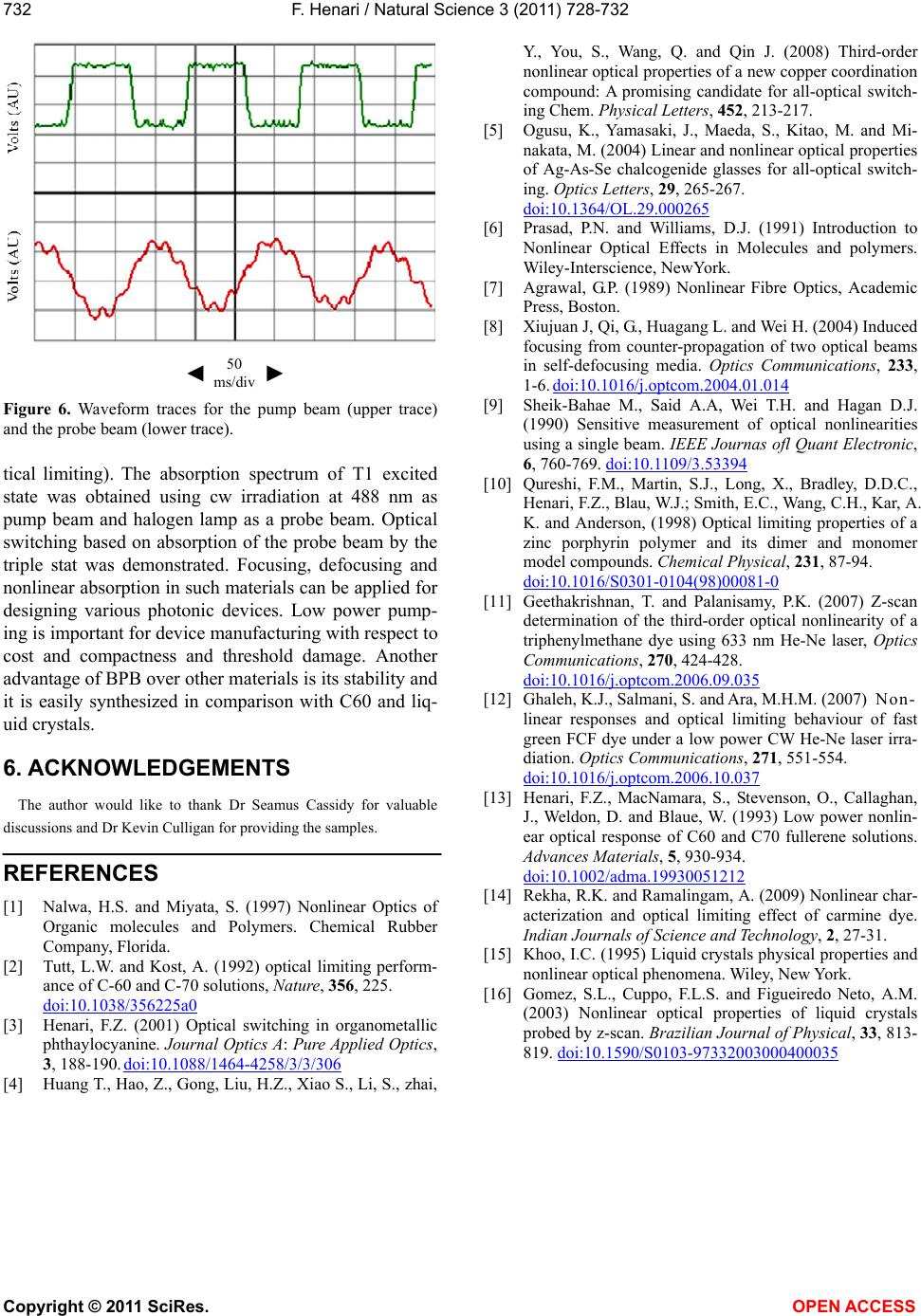
F. Henari / Natural Science 3 (2011) 728-732
Copyright © 2011 SciRes. OPEN ACCESS
732
50
ms/div
◄ ►
Figure 6. Waveform traces for the pump beam (upper trace)
and the probe beam (lower trace).
tical limiting). The absorption spectrum of T1 excited
state was obtained using cw irradiation at 488 nm as
pump beam and halogen lamp as a probe beam. Optical
switching based on absorption of the probe beam by the
triple stat was demonstrated. Focusing, defocusing and
nonlinear absorption in such materials can be applied for
designing various photonic devices. Low power pump-
ing is important for device manufacturing with respect to
cost and compactness and threshold damage. Another
advantage of BPB over other materials is its stability and
it is easily synthesized in comparison with C60 and liq-
uid crystals.
6. ACKNOWLEDGEMENTS
The author would like to thank Dr Seamus Cassidy for valuable
discussions and Dr Kevin Culligan for providing the samples.
REFERENCES
[1] Nalwa, H.S. and Miyata, S. (1997) Nonlinear Optics of
Organic molecules and Polymers. Chemical Rubber
Company, Florida.
[2] Tutt, L.W. and Kost, A. (1992) optical limiting perform-
ance of C-60 and C-70 solutions, Nature, 356, 225.
doi:10.1038/356225a0
[3] Henari, F.Z. (2001) Optical switching in organometallic
phthaylocyanine. Journal Optics A: Pure Applied Optics,
3, 188-190. doi:10.1088/1464-4258/3/3/306
[4] Huang T., Hao, Z., Gong, Liu, H.Z., Xiao S., Li, S., zhai,
Y., You, S., Wang, Q. and Qin J. (2008) Third-order
nonlinear optical properties of a new copper coordination
compound: A promising candidate for all-optical switch-
ing Chem. Physical Letters, 452, 213-217.
[5] Ogusu, K., Yamasaki, J., Maeda, S., Kitao, M. and Mi-
nakata, M. (2004) Linear and nonlinear optical properties
of Ag-As-Se chalcogenide glasses for all-optical switch-
ing. Optics Letters, 29, 265-267.
doi:10.1364/OL.29.000265
[6] Prasad, P.N. and Williams, D.J. (1991) Introduction to
Nonlinear Optical Effects in Molecules and polymers.
Wiley-Interscience, NewYork.
[7] Agrawal, G.P. (1989) Nonlinear Fibre Optics, Academic
Press, Boston.
[8] Xiujuan J, Qi, G., Huagang L. and Wei H. (2004) Induced
focusing from counter-propagation of two optical beams
in self-defocusing media. Optics Communications, 233,
1-6. doi:10.1016/j.optcom.2004.01.014
[9] Sheik-Bahae M., Said A.A, Wei T.H. and Hagan D.J.
(1990) Sensitive measurement of optical nonlinearities
using a single beam. IEEE Journas ofl Quant Electronic,
6, 760-769. doi:10.1109/3.53394
[10] Qureshi, F.M., Martin, S.J., Long, X., Bradley, D.D.C.,
Henari, F.Z., Blau, W.J.; Smith, E.C., Wang, C.H., Kar, A.
K. and Anderson, (1998) Optical limiting properties of a
zinc porphyrin polymer and its dimer and monomer
model compounds. Chemical Physical, 231, 87-94.
doi:10.1016/S0301-0104(98)00081-0
[11] Geethakrishnan, T. and Palanisamy, P.K. (2007) Z-scan
determination of the third-order optical nonlinearity of a
triphenylmethane dye using 633 nm He-Ne laser, Optics
Communications, 270, 424-428.
doi:10.1016/j.optcom.2006.09.035
[12] Ghaleh, K.J., Salmani, S. and Ara, M.H.M. (2007) Non-
linear responses and optical limiting behaviour of fast
green FCF dye under a low power CW He-Ne laser irra-
diation. Optics Communications, 271, 551-554.
doi:10.1016/j.optcom.2006.10.037
[13] Henari, F.Z., MacNamara, S., Stevenson, O., Callaghan,
J., Weldon, D. and Blaue, W. (1993) Low power nonlin-
ear optical response of C60 and C70 fullerene solutions.
Advances Materials, 5, 930-934.
doi:10.1002/adma.19930051212
[14] Rekha, R.K. and Ramalingam, A. (2009) Nonlinear char-
acterization and optical limiting effect of carmine dye.
Indian Journals of Science and Technology, 2, 27-31.
[15] Khoo, I.C. (1995) Liquid crystals physical properties and
nonlinear optical phenomena. Wiley, New York.
[16] Gomez, S.L., Cuppo, F.L.S. and Figueiredo Neto, A.M.
(2003) Nonlinear optical properties of liquid crystals
probed by z-scan. Brazilian Journal of Physical, 33, 813-
819. doi:10.1590/S0103-97332003000400035